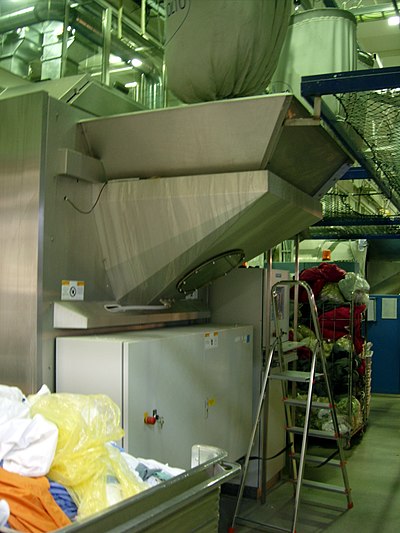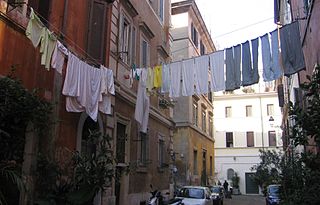
A dishwasher is a machine for cleaning dishware and cutlery automatically. Unlike manual dishwashing, which relies largely on physical scrubbing to remove soiling, the mechanical dishwasher cleans by spraying hot water, typically between 45 and 75 °C, at the dishes, with lower temperatures used for delicate items.

A towel is a piece of absorbent fabric or paper used for drying or wiping a body or a surface. It draws moisture through direct contact, often using a blotting or a rubbing motion.

A clothes dryer, also known as tumble dryer, is a powered household appliance that is used to remove moisture from a load of clothing, bedding and other textiles, usually shortly after they are washed in a washing machine. Otherwise, clothes may also be dried by natural evaporation and, if available, sunlight, on an outdoor or indoor clothes line or clothes horse.
A paper machine is an industrial machine which is used in the pulp and paper industry to create paper in large quantities at high speed. Modern paper-making machines are based on the principles of the Fourdrinier Machine, which uses a moving woven mesh to create a continuous paper web by filtering out the fibres held in a paper stock and producing a continuously moving wet mat of fibre. This is dried in the machine to produce a strong paper web.
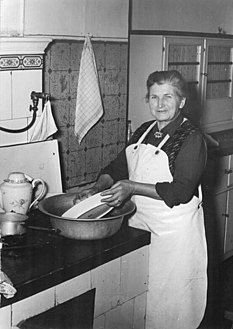
Dishwashing or dish washing, also known as washing up, is the process of cleaning cooking utensils, dishes, cutlery and other items to prevent foodborne illness. This is either achieved by hand in a sink using dishwashing detergent or by using a dishwasher and may take place in a kitchen, utility room, scullery or elsewhere. In Britain to do the washing up also includes to dry and put away. There are cultural divisions over rinsing and drying after washing.

A mangle or wringer is a mechanical laundry aid consisting of two rollers in a sturdy frame, connected by cogs and, in its home version, powered by a hand crank or electricity. While the appliance was originally used to wring water from wet laundry, today mangles are used to press or flatten sheets, tablecloths, kitchen towels, or clothing and other laundry.

The kraft process (also known as kraft pulping or sulfate process) is a process for conversion of wood into wood pulp, which consists of almost pure cellulose fibers, the main component of paper. The kraft process entails treatment of wood chips with a hot mixture of water, sodium hydroxide (NaOH), and sodium sulfide (Na2S), known as white liquor, that breaks the bonds that link lignin, hemicellulose, and cellulose. The technology entails several steps, both mechanical and chemical. It is the dominant method for producing paper. In some situations, the process has been controversial because kraft plants can release odorous products and in some situations produce substantial liquid wastes.

A car wash or auto wash is a facility used to clean the exterior and, in some cases, the interior of motor vehicles. Car washes can be self-serve, fully automated, or full-service with attendants who wash the vehicle. It may also be an event where people pay to have their cars washed by volunteers as a method to raise money for some purpose.
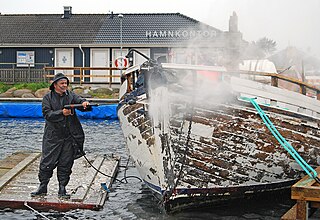
Pressure washing or power washing is the use of high-pressure water spray to remove loose paint, mold, grime, dust, mud, chewing gum and dirt from surfaces and objects such as buildings, vehicles and concrete surfaces. The volume of a mechanical pressure washer is expressed in gallons or litres per minute, often designed into the pump and not variable. The pressure, expressed in pounds per square inch, pascals, or bar, is designed into the pump but can be varied by adjusting the unloader valve. Machines that produce pressures from 750 to 30,000 psi or more are available.
An agitator is a device or mechanism to put something into motion by shaking or stirring. There are several types of agitation machines, including washing machine agitators and magnetic agitators. Agitators can come in many sizes and varieties, depending on the application.

The dispensing ball is a special plastic ball used to dispense liquid fabric softener in clothes washing machines that lack built-in softener dispensers. Liquid fabric softener has to be added at the correct time to a load of laundry in order to work effectively. In top-loading machines, the ball accomplishes this with no user input, other than the initial loading, and filling of the ball.
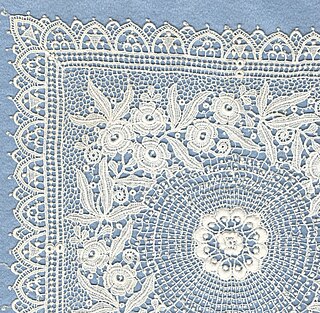
Chemical lace is a form of machine-made lace. This method of lace-making is done by embroidering a pattern on a sacrificial fabric that has been chemically treated so as to disintegrate after the pattern has been created. Schiffli machines came into use in the late 19th century. Before that, embroidery machines called Swiss Handmachine were used to make chemical lace as well as embroideries.
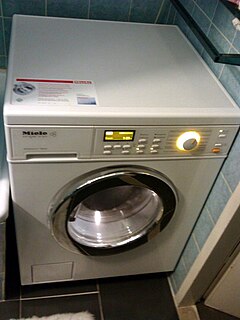
A combo washer dryer is a combination in a single cabinet of a washing machine and a clothes dryer. It should not be confused with a "stackable" combination of a separate washing machine and a separate clothes dryer.
Pot washing is the process of cleaning low to heavily baked-on items off of restaurant kitchen food equipment, including pots, pans, trays, tubs and more.

Kitchen exhaust cleaning is the process of removing grease that has accumulated inside the ducts, hoods, fans and vents of exhaust systems of commercial kitchens. Left uncleaned, kitchen exhaust systems eventually accumulate enough grease to become extreme fire hazards. Exhaust systems must be inspected regularly, at intervals consistent with usage, to determine whether cleaning is needed before a dangerous amount of grease has accumulated.

A parts washer is a piece of equipment used to remove contaminants or debris, such as dirt, grime, carbon, oil, grease, metal chips, cutting fluids, mold release agents, ink, paint, and corrosion from workpieces. Parts washers are used in new manufacturing and remanufacturing processes; they are designed to clean, degrease and dry bulk loads of small or large parts in preparation for assembly, inspection, surface treatment, packaging and distribution. Parts washers may be as simple as the manual "sink-on-a-drum" common to many auto repair shops, or they may be very complex, multi-stage units with pass-through parts handling systems. Parts washers are essential in maintenance, repair and remanufacturing operations as well, from cleaning fasteners, nuts, bolts and screws to diesel engine blocks and related parts, rail bearings, wind turbine gears boxes and automotive assemblies.

The Thor washing machine was the first electric clothes washer sold commercially in the United States. Produced by the Chicago-based Hurley Electric Laundry Equipment Company, the 1907 Thor is believed to be the first electrically powered washer ever manufactured, crediting Hurley as the inventor of the first automatic washing machine. Designed by Hurley engineer Alva J. Fisher, a patent for the new electric Thor was issued on August 9, 1910, three years after its initial invention.
The Xeros Washing Machine is a new kind of clothes washing technology that cleans laundry using primary nylon polymer beads and very little water. The machine releases nylon polymer beads into a main compartment where laundry is washed. These beads are small and super absorbent which allows them to go through clothing to absorb dirt and stains. This technology is invented by University of Leeds professor Stephen Burkinshaw, who currently has partnership with Xeros Ltd. in perfecting this technology.
